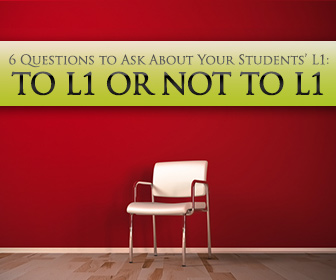To L1 or Not to L1: 6 Practical Questions to Ask About Your Studentsí First Language


Your target is for students to understand and use the English language. However, the biggest tool in your bag to teach them is also the English language. This can put English teachers and students between a rock and a hard place. How can students learn English if you must use English to teach them?
Let me tell you from experience. It’s not impossible to learn a foreign language in an immersion classroom. It happens all the time when babies learn to speak their first languages and students travel overseas or enter English speaking schools. But that doesn’t mean you have to force immersion in your classroom. In fact, sometimes using students’ native languages in class to teach English can be a good thing. The real challenge, however, if finding the right balance between using English and using students’ L1 or first language. If you can find the line and then walk it, your students can learn English even more effectively than they can without their first language.
If you can find the line and then walk it, your students can learn English even more effectively than they can without their first language.
It’s tempting for many ESL teachers to declare their classroom an English only zone – no ifs ands or buts. But there are advantages to using your students’ L1 in the classroom.
Using L1 in the classroom can be a slippery slope, however. Here are some of the disadvantages to allowing students’ first language in class.
Like anything, the best option is to find a balance between two good options, in this case using L1 and having an English only classroom. Here are some tips you can use to find that fine line and walk it.
If you are diligent about looking for that perfect balance and you keep these tips in mind, you are sure to find it. Then your only challenge is to walk that thin line.